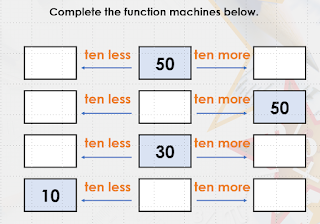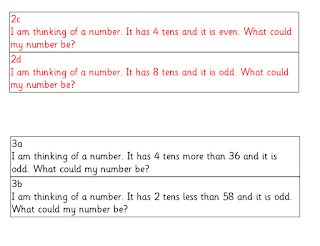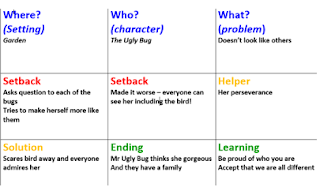In maths this week we have been continued our addition and subtraction learning. We started by using our bonds of numbers to twn, to help with adding multiples of 10. For example, if we know 6 + 2 = 8 we also know that 60 + 20 = 8. Here are some questions you could practise at home.
The next day we made our own number lines and challenged each other to find one more one fewer. We discussed when the ones digit changes and when the tens digit changes. Ask you child if they can explain. We then used our previous learning to find ten more or less than a given number. We discussed what happens to the tens digit and what happens to the ones digit. We practised finding ten more and ten less using a number square. We noticed that if we want to add ten on a number square we can jump one square down, because the numbers are arranged in rows of ten. Here are some questions you could try at home. The next day we used this learning to write and answer number sentences adding or subtracting multiples of ten. We know that, for example, 40 is 4 lots of 10. We know that each row on a number line has 10 numbers, and when we add multiples of ten the tens digit changes but the ones stay the same. We can apply all this learning use efficiently add and subtract multiples of ten. After half term we will be adding and subtracting 2-digit numbers and all of this learning will support us.
This week in English we have
been writing our own versions of the Bee’s Treasure using our plans from last
week.
Ask your child what their best
· story
words
· time words
· adjectives
they used
in their story.
Later in the week we edited our
work with our teachers making simple additions to improve our writing. Ask your child what they had to do to improve their
story.
We had a free writing mini-beast
ChIL where we could choose what to write. Ask your child if they chose a poem, a story or a piece of non-fiction
writing.
Phonics
In phonics this week we have been
recapping the digraphs oo, ew, ue, and the split digraph u-e.
Practise
writing sentences with these digraphs in.
Spellings
Over the half
term we are sending home spellings that are personalised to your child. Please
help them learn these so they can apply the spelling in their own writing.
|
During the last few weeks in
art we have been exploring with clay.
We drew and labelled a plan to show what we intended to make. Over the
next few lessons we used the clay and tools to create our own leaf and
mini-beast. Once it was dried we painted
it and then finished it by adding detail.
|
On
the last lesson we evaluated our clay models using our design criteria. We hope
you like our final models that we have bought home.
Over the holidays, please could you find some simple
instructions to bring into school? We will be writing our own instructions and
it is helpful if the child have the opportunity to look at a range of
instructions to help them see what they need to include. We are also asking children
to bring in a weather chart, as our topic next half term is 'Whatever the
Weather'. Please can you child record the weather pictorially each day
(eg. sunny, rainy, cloudy etc.) and record the temperature. This does not need
to be accurate - BBC weather will be fine! If you away enjoying warmer weather
please could you record the weather at your holiday location as it would be
interesting to compare the weather and then consider any difference based on
the location. Thank you.
We
are all ready for a restful half term, after a long and sometimes challenging
half term. The children have been amazing, we are very proud of them all and we
feel have loved being with them on their move to Year 2. We think we have
all adjusted very well!
We
hope you have a safe and happy half term break and we look forward to seeing
you on Monday 4th November for Autumn 2 and the Christmas play!
Year
Two Team
|
































































